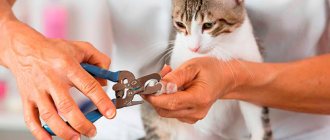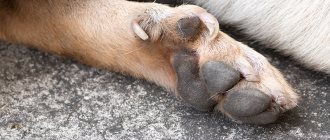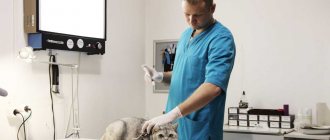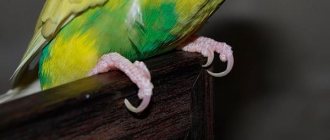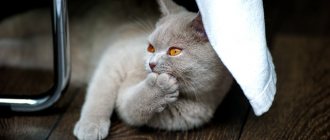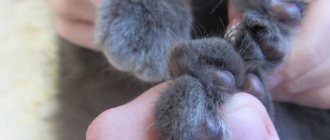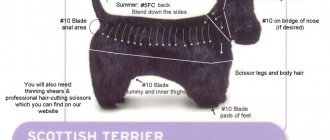Is it possible to trim kittens' claws?
Owners are often interested in the question of at what age can a kitten’s claws be trimmed. You can and should start from an early age, after the baby is one month old. While the animal is small, it perceives everything that happens to it as a game and will easily endure the process.
The baby's claws have not yet fully strengthened. Before cutting your kitten’s nails, you just need to make sure that they are long enough to get in the way of the cub and cling to everything. The kitten needs to be accustomed to stroking its paws and pads, lightly pressing on them a little harder each time until the claw is completely released.
Trimming cat's claws
Thanks to such frequent manipulations, getting used to nail trimming sessions will happen simply and naturally. The matured ward will patiently and resignedly endure the procedure.
Do you need to cut your cat's nails?
If a cat spoils furniture, does not want to use a scratcher, shows aggression towards people, or its claws do not grow properly (this happens quite often), then it is better to trim them.
Sometimes, even while playing with the owner, the cat cannot control the dangerous weapon, clinging to surrounding objects and injuring the person, risking simultaneously injuring himself.
If there are several cats in the house, they are constantly running around, fighting, injuring each other, you should trim their claws.
Reference!
Many people do not immediately notice that the animal’s claws grow into the pads of its paws, which can result in blood remaining on surfaces throughout the house. In such a situation, trimming is definitely required.
Anatomy of claws
A cat's claw is a complex system consisting of muscles, joints, tendons and ligaments. This allows the animal to release it and hide it again.
The visible part of the claw consists of 2 parts: the cornea and the pulp - the living part with blood vessels and nerve endings. Only the upper cornea can be cut off; touching the pulp is strictly prohibited. To do this, it is enough to remove only 2 mm of the tip of the claw.
Periodically, the old layer in the form of a cover is removed from the claws. The fifth claw on the front paws is located on the back side and is never worn down. Over time, it can curl up and grow into the skin.
Important!
You should regularly check the length - it is shorter on the hind legs than on the front legs.
In what cases is it necessary to cut your hair?
When a pet lives in the house and does not go outside, it does not need protection.
He has everything for a comfortable life - housing, food, water, attention. In this regard, the cat's most dangerous weapon is often used for other purposes, causing harm. A strongly overgrown claw bends and hurts the pads of the cat's toes when walking. Breeders are recommended to introduce kittens to nippers from childhood, then problems will not arise in the future.
If the cat is an adult, and the claws need to be trimmed for the first time, you need to be patient to accustom him to grooming. Regular pruning does not require complex skills and it is quite possible to do the procedure yourself at home.
Anomalies: detachments, bifurcation of the claw
When there are no irregularities in the pet’s diet and the claws are cut when necessary, a scratching post is placed in the house, but the claws continue to split or bifurcate - this is a reason to worry about the health of the animal. If a cat periodically limps and does not allow its paws to be touched, this indicates defeat.
In case of injury or improper pruning, infection can penetrate into the soft tissue. This inflammation is called paronychia, and when suppuration forms, it is called pyongychia. In this situation, the most correct decision is to visit a veterinarian in order to:
- getting your pet tested;
- making an accurate diagnosis and prescribing treatment.
Often, an infectious lesion requires a course of antibiotics, or even an operation - opening and draining the infected wound, removing the claw.
Another reason for nail splitting is their abnormal growth. As a rule, this happens in old animals when the thyroid gland produces too many hormones.
Pathologies should also include fungi. They arise under the influence of injury or improper haircut. The main signs of fungal infection:
- unnatural color;
- compaction and thickening;
- swelling and hyperemia around;
- pain in the paw, causing the cat to limp;
- The cat often licks and bites his paw.
Reference!
The fungus is treated with special ointments as prescribed by a veterinarian; sometimes oral treatment with anti-inflammatory drugs is additionally indicated.
What to do if the claw is in the way?
If the owner constantly notices the cat’s discomfort when claws cling to the carpet, upholstered furniture, etc., you need to check the pet’s claws. Perhaps this is a sign of their excessive growth and the need for trimming.
Other reasons
There are other reasons for trimming a cat's claws. For example, a pet damages furniture and shoes, does not respond to scratches, and can scratch the owner or other residents of the apartment, especially if there are small children in the house.
If nails grow abnormally, trimming them is necessary.
Is it possible and necessary to trim cats' claws?
If there is no scratching post in the house or the cat completely ignores it, and at the same time does not have access to the street, it is not only possible, but also necessary to give it a “manicure”. Overgrown sharp tips can break, clinging to fleecy surfaces, exposing the sensitive area of the claw.
When wondering how often to cut a cat’s claws, you need to proceed, first of all, from the individual characteristics of each individual. On average, a cat's nail grows back within 2 weeks. A cat that actively uses a scratching post will double the gap between sessions. Therefore, an adult domestic cat gets a manicure once a month. Kittens' claws grow faster, so their paws need to be cleaned more often - 2 times a month.
For animals leading a sedentary lifestyle, with impaired metabolism, and whose claw growth process is accelerating or slowing down, claw trimming is performed as necessary, periodically inspecting the pet’s paws.
Some breeds (for example, Persians or Sphynxes) need to treat their paws 2 times a month. Their claws grow much faster than those of other breeds and are prone to splitting. It must be taken into account that dark claws grow slower than light ones.
Cats need to have their nails trimmed if there are small children in the house. Another event is always carried out before swimming, planned operations, mating or before participating in an exhibition to avoid injury.
Old and sick animals who find it difficult to monitor the condition of their paws need careful attention. It is better if a specialist does the “manicure” for them.
Persian
Why do you need to care for your cat's claws?
Wild cats either sleep or hunt; in the second case, the animal climbs, climbs, runs, and sneaks. Physical activity causes claws to wear down naturally. What about domestic cats?
Most domestic cats eat, sleep, and lead moderately active lives. Domestic cats do not run on the ground or climb trees. The sharpness of the claws is maintained using a scratching post or other “tenacious” surfaces. It is in the second option that the owner thinks that something needs to be done with the pet’s claws.
How to cut your hair correctly?
It is important for the owner to know how to trim a cat’s claws without harming it.
The nail trimming procedure is absolutely painless and harmless.
Trimming cats' claws at home cannot be done with ordinary scissors intended for people, because they are not adapted to the structure of a cat's claw. Their use can lead to delamination and cracking of the claws.
The owner of a domestic cat must have a set of tools and materials for trimming his pet’s claws:
- nail clipper (scissors) for trimming cat claws;
- nippers for trimming peeled nails that cannot be picked up with scissors;
- nail file for processing sharp edges left after trimming;
- disinfectant solution to treat nail clippers and nippers;
- cotton pads;
- hydrogen peroxide (in case of bleeding).
The blades of scissors for trimming cat claws are made of stainless steel. They have a special shape that covers the claw. Tools must be sharp. Before the procedure, they must be treated with disinfectants.
The “manicure” begins after making sure that the cat is healthy, calm and relaxed (preferably after food or before bedtime). An animal that is frightened or excited by active games should not be subjected to this process. You can and should trim the claws of a domestic cat on the front and back legs. Cutting movements should be performed carefully, sharply and confidently.
nail clipper
Important! You can’t try it on for a long time or fiddle with cutting the claw. The more time spent on one finger, the more nervous the animal will be, and sensing the person’s uncertainty, the cat can completely disrupt the event.
Procedure for trimming cat claws:
- Prepare tools and materials. Clean scissors and hands with alcohol.
- Choose a well-lit place. Place the cat in a position that is comfortable for him and ensure his immobility. You should hold your pet gently, without much pressure, but firmly and confidently. During the ceremony, talk calmly and affectionately to the cat.
- Gently press your index finger and thumb onto the pad that is located under the claw. The cat will reflexively release the entire claw. The ability to extend and retract the claws is caused by the system of tendons, ligaments and muscles located in the phalanges of the cat's fingers. The claw is formed by keratinized epithelium, which contains blood vessels and nerve endings - the pulp.
Important! In claws that are not subject to pigmentation, the pulp is visually visible, highlighted in pink. You can easily see where it ends and can be trimmed. On dark claws it is difficult to discern the boundaries of the sensitive area. To avoid injuring your pet and to perform the procedure correctly, it is better to contact a veterinarian.
- Identify in the light the place where the pulp ends.
- Cut off the tip of the claw 2 mm above the pulp. It is important to hold the instrument strictly perpendicular to the surface being treated during the procedure. If the claw is accidentally injured and the cut touches the pulp, treat the wound with hydrogen peroxide.
- Use a nail file to round off the sharp edges where the cut is made , preventing delamination.
- Having treated one paw, you need to reward the animal for its patience with its favorite treat and proceed to the second paw. In this way, the animal will develop a positive attitude towards the event.
Procedure for trimming claws
You should remember about the fifth toe, which is located on the side surface of the paw, and also treat it as needed. An overgrown claw on it can dig into the pad, causing pain to the animal. Even free-roaming cats have trouble wearing it down.
You can trim a kitten's claws in the same way as an adult cat. The event is carried out in a playful way, without violence or causing physical discomfort to the baby. Before trimming the next claw, the baby is stroked, praised, and rewarded with a treat.
Features of the procedure: step-by-step algorithm of actions
Is it possible to trim a cat's claws at home? It is quite possible to do this. Veterinarians recommend following the following instructions:
- Prepare hydrogen peroxide and cotton pads. Treat instruments with alcohol solution.
- We fix the animal’s paw, hold it tightly, but do not cause pain. If the animal desperately resists desperately, in this case it is better to postpone cutting the claws or entrust it to professionals. If you try to “twist” a restless pet, then there is a high probability of dislocating its leg.
- Lightly press on the soft pad with your fingers on both sides, thereby making the claw appear completely.
- Raise the paw to the light so that the claw can be seen. It is white in color and has a small island of pink inside. This part of the claw should never be touched, because this is where the animal’s nerve endings are located! You only need to cut off the white part, that is, the very tip.
We process each claw in this way. It should be remembered that male cats have five claws on their front paws and four on their hind paws.
During the procedure, be sure to praise the animal, even if it behaves very poorly.
How to prepare for the first procedure
Learning how to trim a cat's claws correctly is not difficult, but it is important to prepare thoroughly in advance. Initially, immediately choosing a convenient tool for carrying out the pruning procedure is quite problematic and you cannot do without tips from specialists.
As a rule, several types of tools are used. Each owner selects the correct appropriate pruning method individually. To trim a cat's claws, I use both regular scissors and those from a manicure set.
If this is your first time trimming your cat’s claws, we recommend that you use our tip and prepare thoroughly. Some owners find it convenient to carry out the procedure using nail clippers. Specialized tools used in veterinary medicine are special scissors for cats - blister, as well as guillotine trimmers.
It is also important for the owner to stock up on a special wool clipper. This will remove excess hair that grows between the cat's pads and toes. It is necessary to have cotton pads and special medications on hand that stop the blood - hydrogen peroxide, tannin or a hemostatic sponge.
In order to carefully file down the cut claw, you will need a manicure file or buff. Before trimming your cat's claws, it is important to choose a convenient tool.
It is recommended that the animal have its own tools for hygiene procedures.
This will reduce the risk of infection if the owner accidentally injures the pet’s fingers during nail trimming.
There are two basic types of nail clippers available in specialized pet stores. They can be guillotine-shaped or crescent-shaped. Sickle-shaped nail clippers for cats are intended for those pets whose plates are unusually strong and it is problematic to cut them with ordinary scissors.
A guillotine trimmer is preferable, since the cut after processing with the tool is much neater and practically does not require further processing with a buff or file.
Experts recommend choosing a high-quality device made of stainless steel and with special silicone handles. This makes it possible to extend the service life of the nail clipper, and its use will be as convenient as possible for the owner, since it will not slip in the hand.
Step-by-step instructions - how to trim a cat's claws correctly
Before starting the procedure itself, it is necessary to prepare the workplace. You should definitely have peroxide, cotton wool, and an antiseptic on hand in case you accidentally get hurt or injure your cat’s claw. Hands must be washed thoroughly and all instruments should be wiped generously with alcohol. Once everything is ready, you can get down to business.
How to properly trim a cat's claws so that the procedure is less painful for your pet, and he does not suffer from severe stress in the future? And most importantly, how can you make sure that next time you don’t have to catch your pet all over the house?
- Treat the nail clipper and hands with alcohol;
- Take the cat in your arms, speak to it tenderly and affectionately, and stroke it at the same time;
- Take the paw and hold it firmly in your hand;
- In order to open the claws, you need to very gently press the center of the pad;
- In order to correctly determine how much of the claw can be removed, you should look at it against the light, then you can see the edge of the corner, and behind it all the blood vessels;
- When cutting the edge of the claw, you need to be very careful not to accidentally catch the pink tissue, since all the blood vessels are located there. If necessary, the claw can be slightly filed;
- The same procedure should be carried out with the remaining claws;
- Even if the cat does not obey, it needs to be calmed, stroked or treated to something tasty;
- There is no need to immediately panic if blood appears from under the claw. There was just a little more trimming than was required. The injured area should be immediately washed with hydrogen peroxide. Usually everything heals very quickly.
- When trimming claws, there is no need to use only a nail clipper; the clippers that people use are perfect for such purposes. You just need to make sure they are sharp.
- If it was not possible to trim the claws in time, it is recommended to use anti-scratch products for cats.
If you are afraid to trim your cat's claws yourself or find it difficult to understand the procedure itself, it is recommended that you contact a clinic or animal salon. This procedure is not very expensive. You just need to take into account that going to a clinic or salon will result in additional stress for your pet. Therefore, either call a specialist to your home or learn how to carry out this procedure yourself.
If, after reading this article, you took the side of the opponents of this process, then we advise you to purchase a special scratching post in the store, this will allow your pet to sharpen its claws freely and at any time. A scratching post is a device specially designed for this purpose. With this device, you are calm and your cat is happy.
Why cats shouldn't have their claws trimmed
This is sadism.
Recently, declawing surgery, or onychectomy, is a very popular procedure in veterinary clinics.
Fearing that a cat might damage expensive furniture with its claws, pet owners simply remove them. In this case, the terminal phalanx of the finger along with the claws is amputated. Scientists say that such a procedure can cause great harm to the health of the animal.
- Cats are digital walking animals; when walking, the emphasis when walking is not on the entire foot, but only on the toes; the heel does not touch the ground. Removal of the terminal phalanx of the toe and shortening of the foot leads to a decrease in the area of support
- the cat cannot walk normally - She will literally have to learn to move again. As a result of improperly distributed load, the activity of the entire musculoskeletal system will be disrupted
. The cat's sense of balance will also become significantly unbalanced, which will be reflected when climbing, jumping and running. - If the operation is performed incorrectly, the removed area may regenerate, and the claw will begin to grow inside the finger
, causing severe pain to the cat and causing an inflammatory process. In this case, a repeat operation cannot be avoided, during which the next phalanx will be amputated. - But even if the declawing operation is successful, the healing process is very painful
. In the best case, only the next day the cat will be able to lean on its paws (which are bandaged after the operation) and try to walk. She will stop limping only after 5-7 days. In addition, the cat will have to wear a protective collar for 10–14 days to prevent it from licking the stitches. - Surgical declawing often condemns the cat to suffering caused by constant pain. And the animals’ character deteriorates
: they become aggressive, capricious, go to the toilet in the wrong place, and cats also actively mark their territory. - After surgery, cats develop back pain, some muscles atrophy, and coordination of movements is impaired
. The absence of the terminal phalanges leads to high stress on the soft edges of the middle phalanges, which causes pain and discomfort. - Sometimes a cat stops using the litter box
: it hurts her to dig into the hard litter. - In some countries around the world - for example, England, Scotland and Brazil - onychectomy is prohibited by law
for ethical reasons.
In general, declawing is always done in the best interest of the individual.
and never in the interests of the animal. If you love your pet, do not condemn him to suffering!
What do you think about this?
Source
